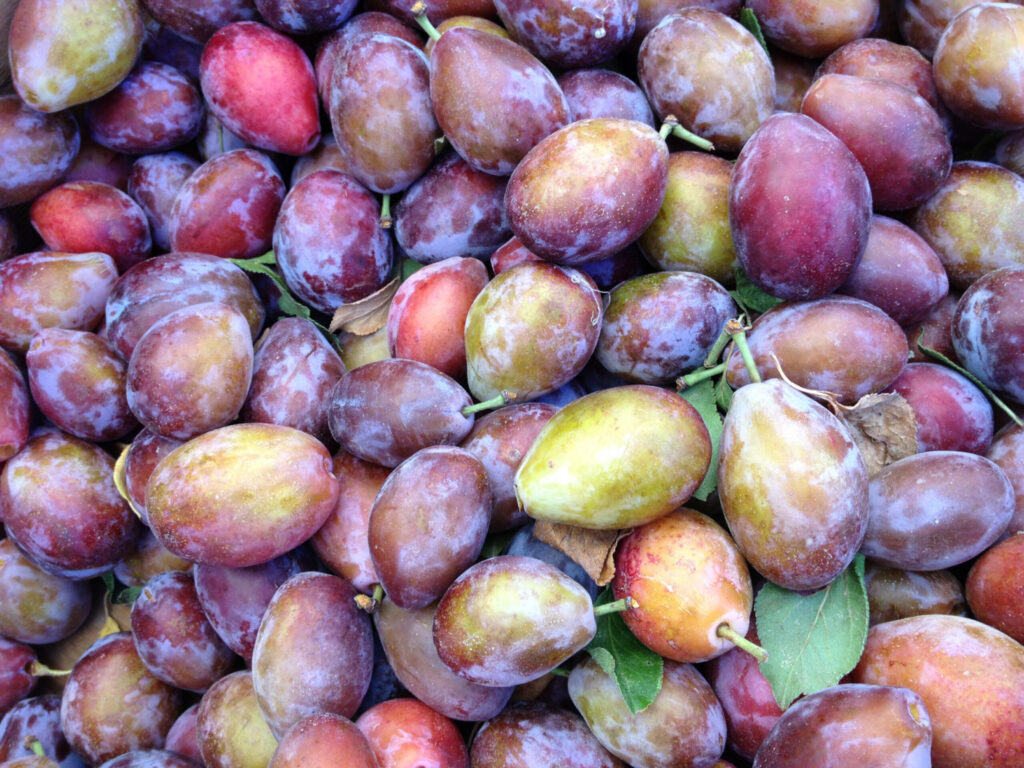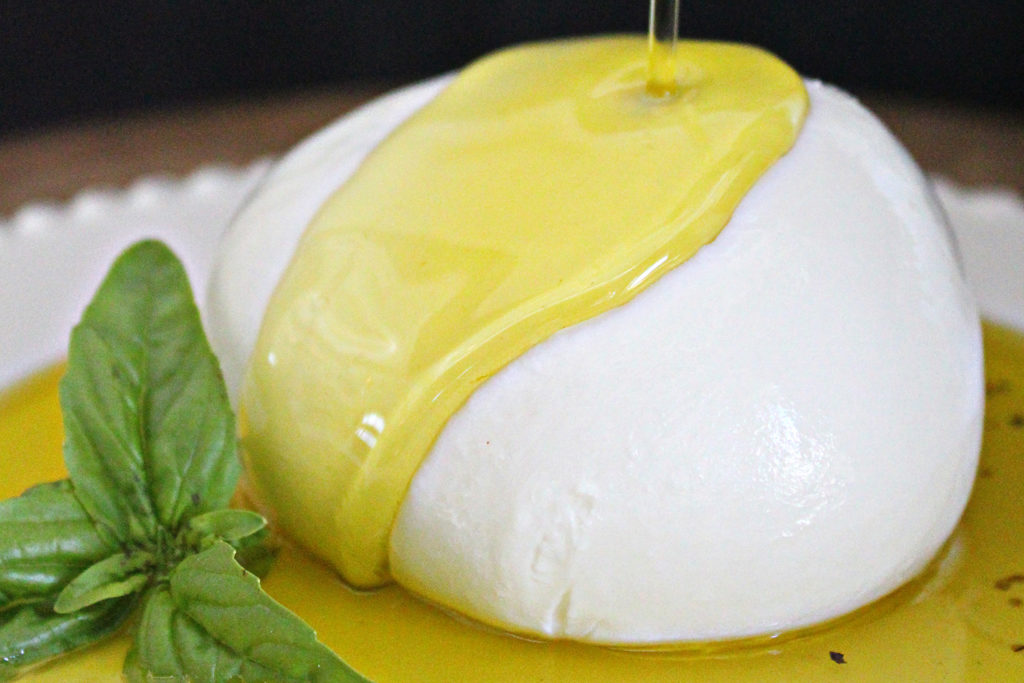10 Unique Foods to Seek Out at the Farmers Market
Selina Knowles, Communications Coordinator
August 4, 2023

With summer in bloom, a farmers market visit will greet you with your seasonal favorites—watermelon, blackberries, corn—as well as some items that may be less familiar—cucamelon, huskcherries, Persian plums. This National Farmers Market Week (August 6-12) is a welcome occasion to celebrate all the freshness, flavor, and variety you can only find at the farmers market, and support local growers who make that bounty possible, while caring for the land and our communities.
Small and mid-sized family farms, like those you’ll find at the Ferry Plaza Farmers Market and Mission Community Market, tend to have more biodiversity, growing heirloom and endangered varieties to preserve these delicious and distinctive foods for future generations. Here are just a few special items you often can look forward to at the farmers market, and rarely anywhere else, this summer and fall. While many summer crops have been delayed this year, you can be on the lookout for some of these unique foods as we get deeper into the season.
Huskcherries (in season now): Also known as gooseberries or ground cherries (pictured above), these tiny members of the nightshade family resemble a cherry tomato in size and texture, with a papery tomatillo-like husk. Remove the husk and eat the fruit, which has a sweet-tart, pineapple-like flavor. The orange berries that are most commonly used for jams and tarts but work well with grilled meats and savory foods, too. Look for huskcherries at Lonely Mountain Farm on Saturdays.

Dry-farmed Early Girl tomatoes (in season now): Early Girl tomatoes can be dry farmed, which means once the plants’ roots are in the ground, they are covered with a protective mulch and the farmer simply stops watering them, a water-conserving technique. Cutting off the water supply means the plants’ roots have to work harder to pull moisture from the ground to produce fruit. The result is a heartier, juicier tomato with more concentrated flavor. On Saturdays at the Ferry Plaza Farmers Market, look for Early Girl tomatoes from Dirty Girl Produce, Everything Under the Sun, and Lucero Organic Farms.

Heritage plums (in season now): Over 2,000 varieties of plums exist, each with a diverse set of shapes and colors, and they are divided into the following six categories: Japanese, American, Ornamental, Damson, Wild, and European. Damsons were most likely first cultivated in Damascus (modern day Syria) from ancient times, and this small, oval-shaped plum variety has a distinctive, somewhat astringent taste that is sought out by jam makers. Look for Damson plums at Blossom Bluff Orchards on Saturdays. From Glashoff Farms and K&J Orchards, try French prune plums, originally brought to the United States from France in 1956. Their sweet taste is versatile and enjoyed both fresh from the tree and in culinary projects.

Nopales (in season now): Nopales are the tender pads from the prickly pear cactus. Their flavor is slightly tart with a wonderful crisp texture. They are delicious roasted, stewed, pan-fried or steamed and make a tasty addition to quesadillas, scrambled eggs or tacos. Find locally grown nopales, with the cactus spines already removed, from Heirloom Organic Gardens at the Ferry Plaza Farmers Market on Saturdays and from Avila Farms at the Mission Community Market on Thursdays.

Costata Romanesco squash (in season now): More than just the common zucchini, summer squash varieties come in different shapes, sizes, and shades of yellow and green. Costata Romanesco is an Italian heirloom variety that is recognizable by its ribbed outer texture (costata means “rib” in Latin). This zucchini has a distinctive medium gray-green color with pale green flecks. It has a soft, thin skin and a nutty flavor. Look for Costata Romanesco at Everything Under the Sun on Tuesdays and Fifth Crow Farm on Saturdays. Also a summer highlight, you can find squash blossoms, which are fragile to pick and have a short shelf life, at Yerena Farms and Oya Organics.

Heirloom cornmeal (year-round): In addition to the fresh sweet corn harvested in the summer, a few farms dedicate space on the farm for dry corn crops. Summer corn is left in the fields to dry and is harvested when fully mature in the fall. Dried corn is then processed throughout the fall, winter, and spring to make fresh cornmeal, which can be used in making polenta, breads, muffins, cookies, tortillas and more. From Tierra Vegetables and Capay Mills, find colorful varieties of heirloom cornmeal, like Tierra’s Toasted and John Deere Green and Capay’s White and Blue. You can also find a rainbow of fresh masa made with landrace maíz, sourced from farms in Mexico, at Bolita.

Buffalo cheese (year-round): Water buffalo made it to the United States in 1975, when researchers thought they could solve a weed problem. They were primarily bred for meat until the 21st century when buffalo mozzarella, an Italian tradition, started gaining popularity in the U.S. It’s favored for its higher butterfat content, calcium, and protein than cow’s milk, with less cholesterol. At the Ferry Plaza Farmers Market on Saturdays, Ramini Mozzarella brings mozzarella, stracciatella, and ricotta, all made with milk from her herd in Sonoma.

Cucamelons (mid-August): Originally from southern Asia, cucumbers reached other parts of the world by being pickled and surviving the long trade routes to the Mediterranean, Northern Africa, and America. Today, you can find many varieties, such as the cucamelon. Also known as Mexican Sour Gherkins or mouse melons, these bite-size cucumbers are slightly sour, and eaten raw or pickled. In Central America, they are known as sandita, meaning “tiny watermelon.” Look for Mexican sour gherkins at Lonely Mountain Farm on Saturdays this summer.

Bronx grapes (late August): With a deep-rosy hue, this rare grape variety, recognized on the Slow Food Foundation for Biodiversity’s Ark of Taste, is a cross between the Thompson and the Black Concord. They have a very delicate skin which makes them difficult to ship or store, so you won’t see them in grocery stores. Later in August, pick up a bunch from Lagier Ranches, one of only two growers in Northern California to cultivate this endangered seedless grape.

Heirloom apples (late summer): There are over 7,500 cultivars of apples, most of which are harvested for eating while some are specifically cultivated for cooking and making into cider. Starting in August at the farmers market, you’ll find new heirloom varieties each week. Many beloved varieties offer a range of flavor and texture, but they have become rare because they don’t meet the demands of industrial agriculture. On Saturdays during summer and fall, keep an eye out for special varieties at Devoto Gardens and Orchards, including Ashmead’s Kernel, one of a very small band of apple varieties from the Old World that succeeded in the New World. Also look for Arkansas Black, Bramley, Gravenstein (a Sebastopol favorite), Roxbury Russet, and Spitzneberg.
Support local farmers and food makers at Foodwise’s farmers market this National Farmers Market Week and year round! Farmers markets support local farms and provide vital access to fresh, healthy food for our communities. By shopping at your local farmers market, you help stimulate local economies, preserve farmland and rural livelihoods, increase access to fresh food, and support healthy communities. Here are our 10 Reasons to Support Farmers Markets.
Topics: Farmers market
